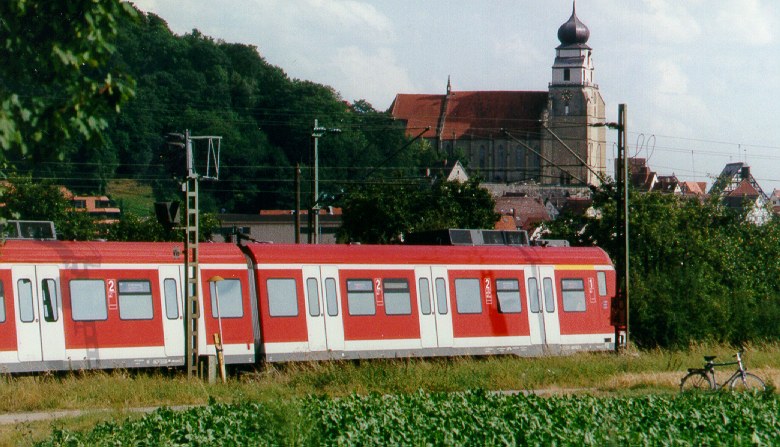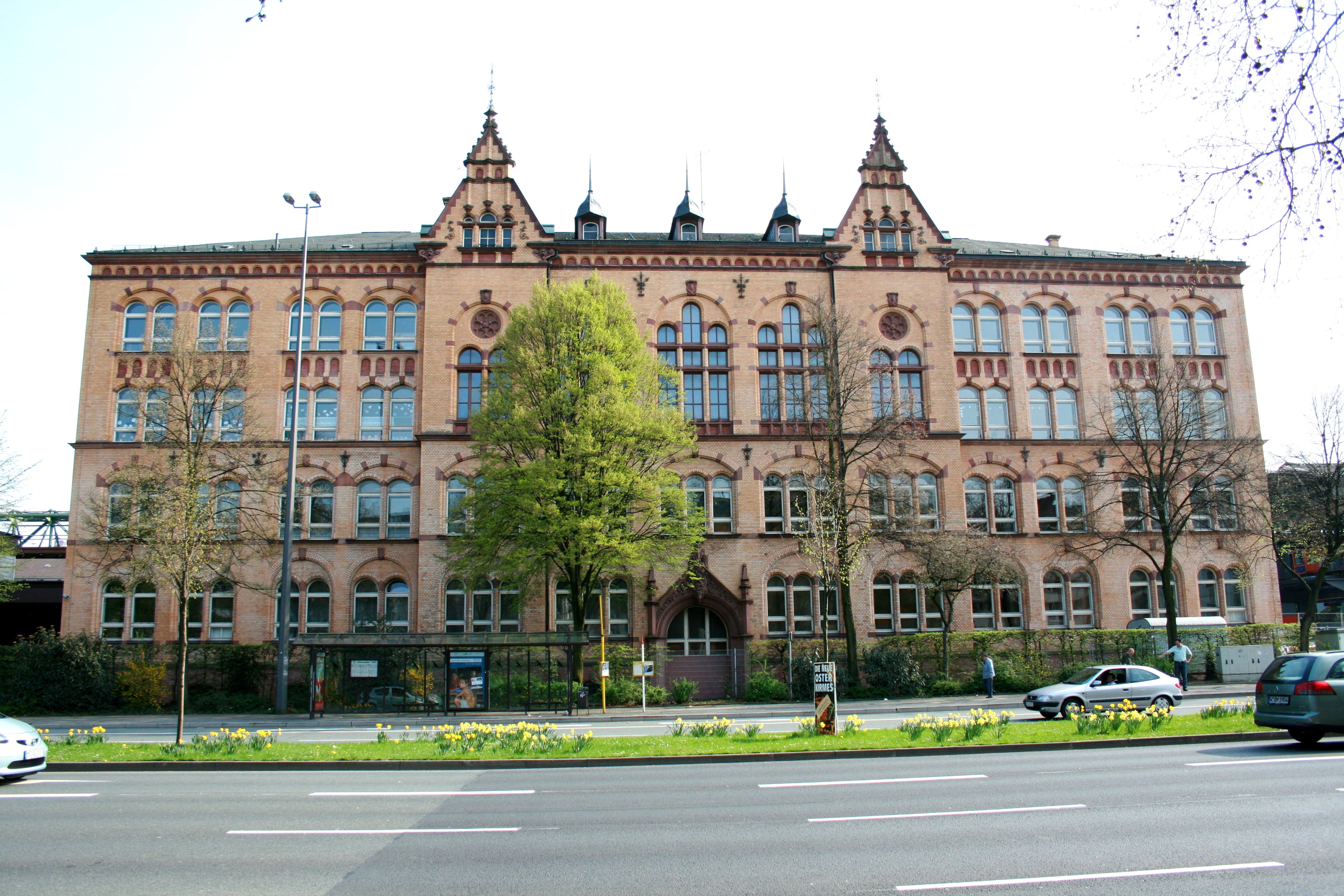|
Nufringen
Nufringen is a municipality ("Gemeinde") in the district of Böblingen in Baden-Württemberg in Germany. Location Nufringen is situated in the Gäu region, of Herrenberg and of Böblingen at the Bundesstraße 14 and at the Gäubahn. History Nufringen was mentioned documentarily first time in the year 1182. In the 13th and 14th century the Pfalzgrafen von Tübingen have had impact on Nufringen until it was sold to Württemberg in 1382. The population was cut drastically because of the Thirty Years' War and the Black Death and did not become as big as before those events happened until the 18th century. Nufringen belongs to the Oberamt Herrenberg since 1806. When the Gäubahn was opened, Nufringen got connection to the big transport networks. Nufringen became part of the Landkreis Böblingen because of administrative reform in 1938. In the World War II 40% of Nufringen were destroyed by an allied bombing raid. After the war Nufringen took a quick upswing. Politics Si ... [...More Info...] [...Related Items...] OR: [Wikipedia] [Google] [Baidu] |
Böblingen (district)
Böblingen is a ''Landkreis'' (district) in the middle of Baden-Württemberg, Germany. Neighboring districts are (from west clockwise) Calw, Enz, Ludwigsburg, (district) Stuttgart, and the districts Esslingen, Reutlingen and Tübingen. History The district was created in 1937 as the successor of the ''Oberamt Böblingen'', which dates back to the Duchy of Württemberg, from the late 15th to the early 19th centuries. In 1973 the majority of the district Leonberg, as well as a few municipalities of the district Calw, were added to the district. A few municipalities were reassigned to the district Ludwigsburg. Geography A part of the district is located in the Black Forest, other landscapes covered are the ''Oberes Gäu'' and the ''Schönbuch Schönbuch is an almost completely wooded area south west of Stuttgart and part of the Southern German Escarpment Landscape (German: ''südwestdeutsches Schichtstufenland''). In 1972 the centre zone of Schönbuch became the first natu ... [...More Info...] [...Related Items...] OR: [Wikipedia] [Google] [Baidu] |
Herrenberg
Herrenberg (Swabian German, Swabian: ''Härrabärg'' or ''Haerebärg'') is a town in the middle of Baden-Württemberg, about 30 km south of Stuttgart and 20 km from Tübingen. After Sindelfingen, Böblingen, and Leonberg, it is the fourth largest town in the district of Böblingen (district), Böblingen. Location Herrenberg is situated on the western edge of the Schönbuch forest and is a central town within the Gäu region. The Stiftskirche, which houses the Glockenmuseum (bell museum), is a tourist attraction in the main square. The following towns and municipalities border Herrenberg. They are listed in clockwise direction beginning in the north: Deckenpfronn, Gärtringen, Nufringen, Hildrizhausen and Altdorf, Böblingen, Altdorf (all Böblingen district), Ammerbuch (Tübingen district), Gäufelden and Jettingen (both Böblingen district) as well as Wildberg, Baden-Württemberg, Wildberg (Calw district). History The once small community Herrenberg was formed out of ... [...More Info...] [...Related Items...] OR: [Wikipedia] [Google] [Baidu] |
Gemeinde (Germany)
MunicipalitiesCountry Compendium. A companion to the English Style Guide European Commission, May 2021, pages 58–59. (german: Gemeinden, ) are the lowest level of official territorial division in . This can be the second, third, fourth or fifth level of territorial division, depending on the status of the municipality and the '''' (federal state) it ... [...More Info...] [...Related Items...] OR: [Wikipedia] [Google] [Baidu] |
12th-century Establishments In The Holy Roman Empire
1 (one, unit, unity) is a number representing a single or the only entity. 1 is also a numerical digit and represents a single unit of counting or measurement. For example, a line segment of ''unit length'' is a line segment of length 1. In conventions of sign where zero is considered neither positive nor negative, 1 is the first and smallest positive integer. It is also sometimes considered the first of the infinite sequence of natural numbers, followed by 2, although by other definitions 1 is the second natural number, following 0. The fundamental mathematical property of 1 is to be a multiplicative identity, meaning that any number multiplied by 1 equals the same number. Most if not all properties of 1 can be deduced from this. In advanced mathematics, a multiplicative identity is often denoted 1, even if it is not a number. 1 is by convention not considered a prime number; this was not universally accepted until the mid-20th century. Additionally, 1 is the s ... [...More Info...] [...Related Items...] OR: [Wikipedia] [Google] [Baidu] |
Bundesautobahn 81
is a motorway in Germany. It branches off the A 3 at the Würzburg-West triangle and ends near the border with Switzerland. The oldest part of the A 81 between the Weinsberg intersection ( A 6) near Heilbronn and Dreieck Leonberg ( A 8) near Stuttgart was finished in the years 1938 to 1940. This section included the first tunnel built for an autobahn, the first Engelberg tunnel near Leonberg. When Weinsberg-Leonberg was upgraded to 3+3 lanes in the 1970s, the tunnel with its two lanes each and steep grades (up to 6%) became something of a bottleneck. In 1999 a new Engelberg tunnel was opened. Original plans called for the A 81 to be continued northwards skirting the north-west of Würzburg to join up with the A 7, but these plans were later abandoned. Instead, the A 81 shares a part of the A 8 to the Stuttgart intersection and then continues south on a motorway that was built as A 831 to Gärtringen, where it meets the original l ... [...More Info...] [...Related Items...] OR: [Wikipedia] [Google] [Baidu] |
Commuter Town
A commuter town is a populated area that is primarily residential rather than commercial or industrial. Routine travel from home to work and back is called commuting, which is where the term comes from. A commuter town may be called by many other terms: "bedroom community" (Canada and northeastern US), "bedroom town", "bedroom suburb" (US), "dormitory town", or "dormitory suburb" (Britain/ Commonwealth/Ireland). In Japan, a commuter town may be referred to by the ''wasei-eigo'' coinage . The term "exurb" was used from the 1950s, but since 2006, is generally used for areas beyond suburbs and specifically less densely built than the suburbs to which the exurbs' residents commute. Causes Often commuter towns form when workers in a region cannot afford to live where they work and must seek residency in another town with a lower cost of living. The late 20th century, the dot-com bubble and United States housing bubble drove housing costs in Californian metropolitan areas to hist ... [...More Info...] [...Related Items...] OR: [Wikipedia] [Google] [Baidu] |
Werkrealschule
Werkrealschule is a relatively young branch of German secondary education (e.g. in Baden-Württemberg), which offers pupils additional lessons in grades 8 and 9 and allows them to qualify after ten years with a final exam which is equal to graduation from Realschule ''Realschule'' () is a type of secondary school in Germany, Switzerland and Liechtenstein. It has also existed in Croatia (''realna gimnazija''), the Austrian Empire, the German Empire, Denmark and Norway (''realskole''), Sweden (''realskola''), .... Education in Germany {{Europe-edu-stub ... [...More Info...] [...Related Items...] OR: [Wikipedia] [Google] [Baidu] |
Hauptschule
A ''Hauptschule'' (, "general school") is a secondary school in Germany, starting after four years of elementary schooling (''Grundschule''), which offers Lower Secondary Education (Level 2) according to the International Standard Classification of Education. Any student who attends a German elementary school can go to a ''Hauptschule'' or ''Gesamtschule'', while students who want to attend a ''Realschule'' or '' Gymnasium'' need to have good marks in order to do so. The students spend five to six years at the ''Hauptschule'', from 5th to 9th (or 10th) grade. They finish around age 15 to 17. History ''Hauptschulen'' (plural for Hauptschule) were first introduced in West Germany in 1950 and are now a part of secondary education in Germany, the other schools being the '' Gymnasium'' for the university-bound and the ''Realschule'' for the future technicians. Basics The main aim of ''Hauptschulen'' is to offer young students with average grades or below, most of whom will not attend ... [...More Info...] [...Related Items...] OR: [Wikipedia] [Google] [Baidu] |
Education In Germany
Education in Germany is primarily the responsibility of individual German states (), with the federal government playing a minor role. Optional Kindergarden (nursery school) education is provided for all children between one and six years old, after which school attendance is compulsory. Overall, Germany is one of the best performing OECD countries in reading literacy, mathematics and sciences with the average student scoring 515 in the PISA Assessment Test, well above the OECD average of 497 points. Germany has a less competitive system, leading to low rates of bullying and students having a weak fear of failure but a high level of self-confidence and general happiness compared to other OECD countries like South Korea. Additionally, Germany has one of the largest percentage of top performers in reading among socio-economically advantaged students, ranking 3rd out of 76 OECD countries. This leads to Germany having one of the highest-educated labour forces among OECD countrie ... [...More Info...] [...Related Items...] OR: [Wikipedia] [Google] [Baidu] |
S-Bahn Stuttgart
The Stuttgart S-Bahn is a suburban railway system (S-Bahn) serving the Stuttgart Region, an urban agglomeration of around 2.7 million people, consisting of the city of Stuttgart and the adjacent districts of Esslingen, Böblingen, Ludwigsburg and Rems-Murr-Kreis. The Stuttgart S-Bahn comprises seven lines numbered S1 through S6 and S60, and is operated by ''S-Bahn Stuttgart'', a subsidiary of Deutsche Bahn. The system is integrated with the regional transport cooperative, the Verkehrs- und Tarifverbund Stuttgart (VVS), which coordinates tickets and fares among all transport operators in the metropolitan area. Lines All lines lead through the city centre of Stuttgart. The northeastern end of the tunnel (from the tracks near ''Stuttgart Hauptbahnhof'' through '' Schwabstraße'') was the first part of the tunnel to open and has been used since the beginning, the southwestern end from ''Schwabstraße'' through Universität since 1985. The main node to change for ''Stuttgart ... [...More Info...] [...Related Items...] OR: [Wikipedia] [Google] [Baidu] |
Stuttgart
Stuttgart (; Swabian: ; ) is the capital and largest city of the German state of Baden-Württemberg. It is located on the Neckar river in a fertile valley known as the ''Stuttgarter Kessel'' (Stuttgart Cauldron) and lies an hour from the Swabian Jura and the Black Forest. Stuttgart has a population of 635,911, making it the sixth largest city in Germany. 2.8 million people live in the city's administrative region and 5.3 million people in its metropolitan area, making it the fourth largest metropolitan area in Germany. The city and metropolitan area are consistently ranked among the top 20 European metropolitan areas by GDP; Mercer listed Stuttgart as 21st on its 2015 list of cities by quality of living; innovation agency 2thinknow ranked the city 24th globally out of 442 cities in its Innovation Cities Index; and the Globalization and World Cities Research Network ranked the city as a Beta-status global city in their 2020 survey. Stuttgart was one of the host cities ... [...More Info...] [...Related Items...] OR: [Wikipedia] [Google] [Baidu] |
Kirchheim-Teck
Kirchheim unter Teck (Swabian German, Swabian: ''Kircha'') is a town in Baden-Württemberg, Germany, in the Esslingen (district), district of Esslingen. It is located on the small river Lauter (Neckar), Lauter, a tributary of the Neckar. It is 10 km (6 miles) near the Burg Teck, Teck castle, approximately southeast of Stuttgart. It is the fourth city in the Esslingen (district), Esslingen district, forming a district centre for the surrounding communities. Since 1 April 1956, Kirchheim unter Teck has the status of Große Kreisstadt. The city forms a ''Verwaltungsgemeinschaft'' (administrative community) with the neighbouring municipalities Dettingen unter Teck, Dettingen and Notzingen. Kirchheim unter Teck was also, for several centuries, seat of the Oberamt Oberamt Kirchheim, (Oa.) Kirchheim. Geography Kirchheim unter Teck is located in the foothills of the central Swabian Jura, Swabian ''Alb'', north of the Albtrauf escarpment and its foothills: the Teckberg, Breitenst ... [...More Info...] [...Related Items...] OR: [Wikipedia] [Google] [Baidu] |







